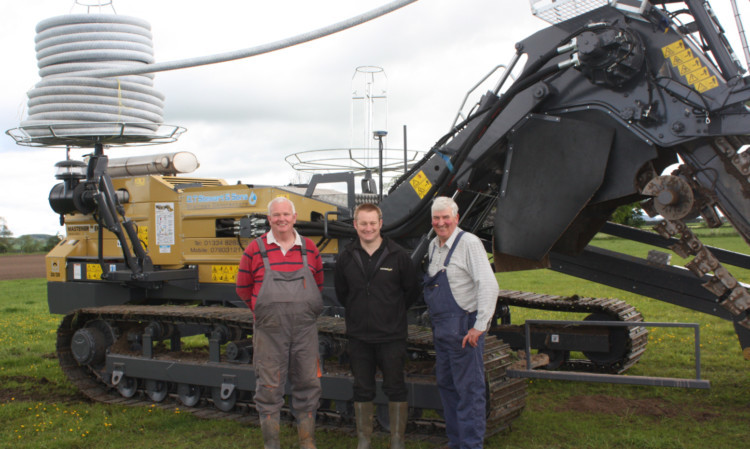Ceres-based draining contractors DT Stewart & Sons have just taken delivery of what is believed to be the first large new trenching machine to come to Scotland for many years.
The 22-tonne Mastenbroek 30-20 represents a substantial £300,000 investment by David Stewart and his brother Bob.
They are the third generation of the family to have been involved in the business and see the commitment to the new machine as being justified by the amount of farm drainage now being undertaken in Fife and beyond.
Fred Clarke of Mastenbroek confirmed this was a trend across the country.
Five years ago the Lincolnshire based firm was making as few as five self-propelled trenchers annually, but this year it expects to make 15.
“I put it partly down to climate change and the need for better drainage during prolonged wet spells.
“Also land prices have increased substantially and farmers want to make the most of every acre.
“We are seeing this right across the northern hemisphere,” he added.
The Mastenbroek business was founded in Boston by John Mastenbroek in 1956 as an importer for Dutch machines.
Before long, however, he was manufacturing his own machines and the business now employs 40 staff.
David Stewart admitted the decision to buy a new machine was not an easy one but he was convinced there would be plenty of work.
“We chose a trenching machine with a relatively narrow 130mm chain because it reduces the need for gravel backfill, but we can put on wider teeth if need be,” said David Stewart.
“The alternative would have been a drainage plough, which is good on stonier ground but causes more heave.”
The new machine with its 335hp engine has the power to work down to 2.2 metres, and in good conditions should lay 2,000 metres of pipe per day.
Within a day of being delivered the Mastenbroek was at work at David McKerrow’s Nochnary Farm at Freuchie.
The farm grows cereals, grass, potatoes and vegetables and the soil is very sandy and stone free.
The field being drained lies close to the River Eden, with the new system based on 10-metre spacing, with the drains leading directly into a ditch.
Mr McKerrow said the lower parts of the field had been sitting in water over much of the winter and although the surface appeared dry last Friday, within half an hour of each drain being laid the pipes were running half full.
This is impressive considering the ‘fall’ was only 3cm per 20m of run.
The pipes being laid were filter-wrapped, and although there is an extra expense involved Mr McKerrow was sure it was justified to avoid them being quickly choked with fine sand.
For Mr Stewart it was a case of coming to grips with the new technology on the machine.
It is fitted with the latest GPS technology to keep working depth accurate to a couple of millimetres.
An in-cab Trimble system looks after depth and gradient, allowing the operator to concentrate on steering and supervising the whole operation.
